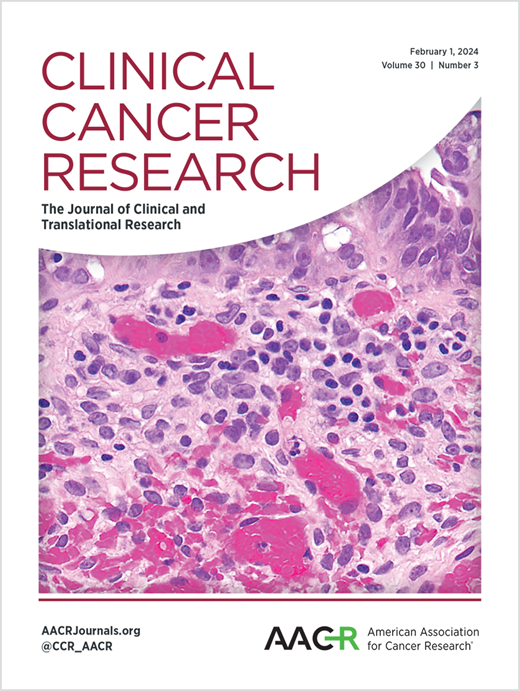NCI-MATCH试验中肿瘤组织与血浆DNA基因分型的一致性(EAY131)
IF 10
1区 医学
Q1 ONCOLOGY
引用次数: 0
摘要
目的:液体活检与循环肿瘤DNA (ctDNA)分析越来越多地被用作一种非侵入性方法来识别晚期/转移性癌症中可操作的基因组改变。在此,我们报告了NCI-MATCH试验中收集的患者血浆样本的ctDNA分析与基于肿瘤组织的测序之间的相关性。患者和方法:我们分析了从NCI-MATCH的16个亚方案中收集的血浆样本,这些患者在开始治疗前90天内收集了血浆样本。一致性被定义为在组织和血浆中检测到相同的基因改变导致患者入组NCI-MATCH。结果:我们纳入了300例纳入NCI-MATCH的患者。大多数患者(81%,n=243)是根据中心组织检测入组的,同时有组织和血浆样本。81.1% (n=197)的患者血浆中检出感兴趣的组织改变。在57例患者的样本中观察到较低的组织改变检出率,这些患者是根据外部指定实验室检测入组的(56.1%,n=32),并且具有非同期组织和血浆样本。不同的变异类型、最大血浆变异等位基因频率和肿瘤活检部位观察到一致性率的变化。结论:81%的NCI-MATCH试验患者的血浆中检测到感兴趣的肿瘤组织改变,这些患者基于中心组织检测,并有同期的组织和血浆样本。这表明液体活检在评估生物标志物驱动的抗癌治疗的试验中有潜在的作用。本文章由计算机程序翻译,如有差异,请以英文原文为准。
Concordance between tumor tissue and plasma DNA genotyping in the NCI-MATCH trial (EAY131)
Purpose: Liquid biopsies with circulating tumor DNA (ctDNA) analysis are increasingly being utilized as a non-invasive approach to identify actionable genomic alterations in advanced/metastatic cancers. Herein, we report the correlation between ctDNA analysis of plasma samples collected from patients enrolled in the NCI-MATCH trial and tumor tissue-based sequencing. Patients and Methods: We analyzed plasma samples collected from patients enrolled on 16 subprotocols of NCI-MATCH who had plasma samples collected within 90 days before starting treatment. Concordance was defined as the detection of the same gene alteration leading to patient enrollment in NCI-MATCH in both tissue and plasma. Results: We included 300 patients who were enrolled in NCI-MATCH. Most patients (81%, n=243) were enrolled based on central tissue testing and had contemporaneous tissue and plasma samples. The tissue alteration of interest was detected in the plasma of 81.1% (n=197) of patients. Lower rates of detection of the tissue alteration of interest were observed in samples from 57 patients who were enrolled based on outside designated laboratory testing (56.1%, n=32) and had non-contemporaneous tissue and plasma samples. Variations in concordance rates were observed with different alteration types, by maximum plasma variant allelic frequency, and based on tumor biopsy site. Conclusions: The tumor tissue alteration of interest was detected in the plasma of 81% of patients who were enrolled in the NCI-MATCH trial based on central tissue testing and had contemporaneous tissue and plasma samples. This suggests a potential role for liquid biopsy in patients’ enrollment in trials evaluating biomarker-driven anticancer therapies.
求助全文
通过发布文献求助,成功后即可免费获取论文全文。
去求助
来源期刊

Clinical Cancer Research
医学-肿瘤学
CiteScore
20.10
自引率
1.70%
发文量
1207
审稿时长
2.1 months
期刊介绍:
Clinical Cancer Research is a journal focusing on groundbreaking research in cancer, specifically in the areas where the laboratory and the clinic intersect. Our primary interest lies in clinical trials that investigate novel treatments, accompanied by research on pharmacology, molecular alterations, and biomarkers that can predict response or resistance to these treatments. Furthermore, we prioritize laboratory and animal studies that explore new drugs and targeted agents with the potential to advance to clinical trials. We also encourage research on targetable mechanisms of cancer development, progression, and metastasis.
 求助内容:
求助内容: 应助结果提醒方式:
应助结果提醒方式:


